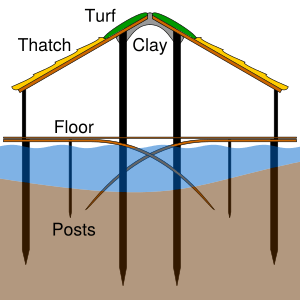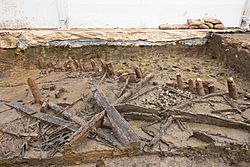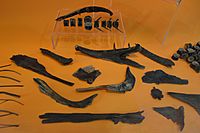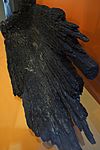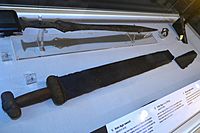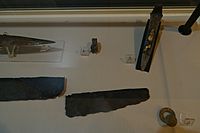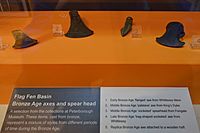Must Farm Bronze Age settlement facts for kids
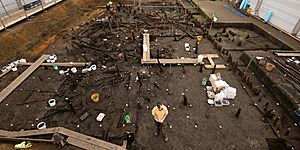 |
|
| Location | Whittlesey, Cambridgeshire, England |
|---|---|
| Coordinates | 52°33′18.85″N 0°10′38.35″W / 52.5552361°N 0.1773194°W |
| History | |
| Material | Wood |
| Periods | Bronze Age |
| Site notes | |
| Archaeologists | Cambridge Archaeological Unit |
| Public access | No |
Must Farm is an amazing archaeological site in Cambridgeshire, England. It's where parts of a Bronze Age settlement were found. This ancient village was discovered in a quarry near Whittlesey, close to Peterborough.
Archaeologists call Must Farm "Britain's Pompeii". This is because the site is incredibly well-preserved. It holds the best-kept Bronze Age homes ever found in Britain. It seems the village was suddenly abandoned after a huge fire. Scientists now think the settlement was less than a year old when it was destroyed.
The site sits on the bed of an old river in the Flag Fen area. It's about 2 kilometers (1.2 miles) south of Flag Fen itself. Must Farm has won several awards for its discoveries. It was named Best Archaeological Project in 2012 and Best Discovery in 2016.
Contents
Discovering the Past at Must Farm
Archaeologists first noticed wooden posts at Must Farm in 1999. This led to small digs in 2004 and 2006. Even earlier, in 1969, a rapier (a type of sword) and another sword were found here.
Ancient Boats and Tools
Between 2011 and 2012, eight Bronze Age log boats were discovered. These boats were found in a small, ancient river channel. They were kept safe because they were waterlogged, meaning they were completely covered in water and mud. This stopped them from rotting away.
Scientists used Radiocarbon dating to find out how old these boats were. This method tells us the age of ancient objects. The boats ranged in age over about 1,000 years. The oldest ones were from around 1750–1650 BCE (Before Common Era). Some boats might have been sunk on purpose. Today, you can see these ancient boats at Flag Fen on guided tours.
In the same river channel, archaeologists also found woven wooden fish traps. They also found wattle-hurdle fish weirs, which were fences used to catch fish. Along with these, metal objects like swords and spears were uncovered.
The Big Dig of 2015 and 2016
In September 2015, the Cambridge Archaeological Unit from the University of Cambridge started a large dig. They explored an area of about 1,100 square meters (1,315 square yards). The exciting details were shared with the public in January 2016.
Historic England helped pay for this big project. They spent £1.1 million to dig up the site. The goal was to learn as much as possible about what life was like in Britain during the Bronze Age.
Archaeologists found two roundhouses from about 1000–800 BCE. They believe these homes were damaged by fire. Then, the platform they sat on slid into the river. The water put out the fire, and the buildings and everything inside them were preserved in the soft mud, called silt. Sadly, about half of the settlement was lost due to modern quarrying.
Amazing Finds from the Dig
The objects found at Must Farm are truly special. They include pots that still had food inside them! There were also textiles (fabrics) made from lime tree bark and other plant fibres. Pieces of wattle walls (woven branches and sticks) were also found. Even tiny glass beads were discovered.
In 2016, a large wooden wheel was uncovered. It was about 1 meter (3.3 feet) across. This wheel dates back to 1,100 to 800 BCE. It is the most complete and oldest wheel of its kind found in Britain. The center part of the wheel, called the hub, was also there. A horse's spine found nearby suggests the wheel might have been part of a horse-drawn cart.
Duncan Wilson, who leads Historic England, said this find "expands our understanding of late Bronze Age technology." This means it helps us learn more about the tools and skills people had back then. By August 2016, all the archaeological finds had been carefully removed. The site was then reburied to keep it safe.
Learning About Ancient Health
In 2019, researchers from Cambridge and Bristol universities studied ancient human and dog waste found at the site. They discovered evidence of different types of worms, like fish tapeworms. This research shows the earliest proof of these parasites infecting humans in Britain. It helps us understand the health and diet of people living in the Bronze Age.
The amazing dig at Must Farm was featured in a BBC Television show. It was called Britain's Pompeii: A Village Lost in Time. The show was first shown on BBC Four on August 2, 2016. The excavation became famous for sharing its discoveries widely online.
Artefacts from Must Farm
These are some of the cool objects found at Must Farm. They were photographed at Peterborough Museum in July 2017:


